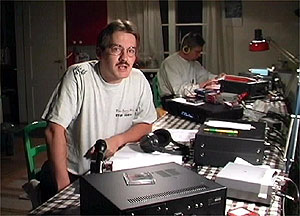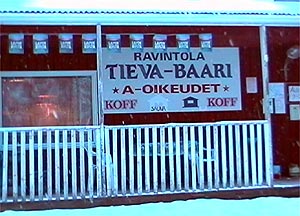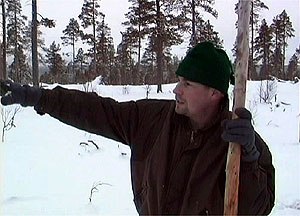|
LEM132 DXpedition Report
November 15th - 22nd 1999
by Mika Mäkeläinen
This DXpedition was unique
in one sense; it has received unprecedented media
attention. First, during the DXpedition, a report
with an interview of Jim
Solatie was aired on Kotimaan katsaus, a current
affairs program on YLE TV2, the second channel of
the Finnish
Broadcasting Company (YLE). Also I, Mika
Mäkeläinen reported on DXing - focusing
on our DXpedition - for CNN
International.
 |
| Mika Mäkeläinen |
My report for CNN was aired on
World
Report on December 7th and 12th 1999. Thanks
to all who have sent comments on the story! With
a potential audience of 400 million TV households
around the world, a few more people may now have
some idea of what DXing is. The publicity was of
course focused on the strange and exotic phenomenon
of DXers camping in the Arctic in general - the
results of this particular DXpedition were not spectacular
enough to warrant any special attention on the hobby,
although we are very happy with our catches.
Our journey to Lemmenjoki
began on the evening of Sunday, November 14th, at
the Helsinki railway station. Jim's 4-wheel drive
Honda was packed on the train and we slept through
the night, arriving in Rovaniemi on the Arctic circle
after 12 hours.
Our first stopover was Kittilä
some 180 kilometers northwest, to buy groceries
for the week. An old lady in the cashier line ahead
of me was astonished: "My God, am I glad I'm
not standing behind you! You must have enough to
eat for a month, or two months!". Well, we
did consume almost everything... And since our
culinary expertise is limited to switching the microwave
oven on, we decided to enjoy a large pizza before
leaving the last outpost of civilization.
 |
| Tieva-baari in Pokka |
Well, almost the last anyway.
On the way to Lemmenjoki there is the legendary
Tieva-baari in the tiny village of Pokka. A cafe
would be an overstatement, more to the point it's
the only place within a radius of about 100 kilometers
where alcohol is served. During our last visit there
in 1998 the locals looked at us suspiciously, kept
silent from the minute we stepped in, and, one by
one, left the place... This time we only encountered
a dozen military personnel with their snow mobiles
parked outside!
After a couple of hours drive
from Kittilä we arrived in Lemmenjoki after
3 p.m. The scene already looked quite wintry with
the nearby lake frozen and about 10 centimeters
of snow on the ground. It snowed more in the coming
days with temperatures between -5 and -15 degrees
Celsius. By the end of our DXpedition, the weather
became warmer again and some of the snow melted
away. With mostly sub-zero temperatures, we kept
the cabin warm by using the fireplace almost non-stop.
LEM132 was the 4th DXpedition
of the season to Lemmenjoki. This fall some new
equipment had been added; an antenna pointing at
70 degrees, which we expected to yield good catches
from South-East Asia. Also, a new kind of antenna
splitter was in place, and allowed a record number
of antennae for both users. More on our equipment
here.
Because of a major magnetic storm
forecast, we adjusted our timing by arriving five
days earlier than originally planned. A day before
heading north, the Northern lights (aurora borealis)
were visible as far south as Helsinki. This is very
rare, and the surprising lightshow was clearly an
indication of poor conditions on the dial, so revising
our schedule made our prospects only worse. Anyhow,
this time there seemed to be hardly any correlation
between solar indices and good conditions.
 |
| Jim Solatie |
Taking a closer look at different
targets, North America was traditionally one of
our main areas of interest. When we got our gear
in order just before 1400 UTC (4 p.m. local time)
on Monday, NA West Coast signals were pretty good.
That lasted for ten minutes, after which very few
North American stations were heard for the following
five days. There was only a short peak in the signals
around 0700 UTC, at sunrise local time. The situation
improved somewhat on Sunday, Nov. 21st, when signals
were heard also in the afternoon. The conditions
improved even more on Monday morning, when we were
supposed to leave. To catch some more U.S. stations,
we took a one-day extension with the kind approval
of our wives. When conditions allowed, we usually
hunted the X-band stations and left the other set
to record some graveyard frequency. A bunch of Alaskan
and Hawaiian stations were audible on several days,
but nothing new for us.
Central American and Caribbean
signals were practically non-existent. We got some
nice openings to South America just before sunrise
(around 0600 UTC), especially to the southern part
of Brazil, but otherwise South Americans were few.
No sign of the Falklands on 530 kHz. Shortwave signals
were extremely poor, both at night and in the morning.
We had high hopes concerning
Asia, and it was indeed the most productive continent
in terms of new catches. The new beverage antenna
was very good for southern China, Vietnam and Thailand.
There still isn't a decent antenna for India, but
this new antenna slightly improved reception even
from that area. Conditions to Japan were good on
Tuesday, Nov. 16th, when even frequencies such as
1359 and 1467 kHz yielded interesting NHK stations.
Overall, the best catch from Asia was probably Jim's
Indonesian station on 1485 kHz. Even though RRI
Jakarta was audible on 999 kHz on several days,
only one Australian AM station was heard. An intense
search for new Pacific countries was fruitless.
From Africa the most interesting
catch was definitely Emissora Provincial de Benguela
on 1502 kHz, which we both have hunted for years.
The Iberian peninsula was not too bad, but we could
have had better luck; excellent conditions were
observed in the morning of Sunday, Nov. 21st, but
since there were no local breaks on Sunday morning,
the peak was useless. In the evenings and mornings
we spent quite a lot of time listening to the rest
of Europe, partly because on some occasions not
much else was audible. The biggest surprise near
the home front was Radiophonikos Stathmos Amaliadas
from Greece on 1584 kHz, which we thought would
have been extinct for years.
For the first five days, not
much was heard in the daytime around 0700-1300 UTC,
so we had ample time to check the antennae. Still,
overall, I consider the catch pretty good under
the circumstances of high solar activity. We both
got over 100 stations that were new to us.
Finally, for details on the identified
stations, here's the LEM132
DXpedition log you have been waiting for. For
some logging guidelines, check out notes
on the log.
Posted on November
25th 1999, last update on June 10th 2000
  
|